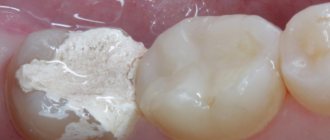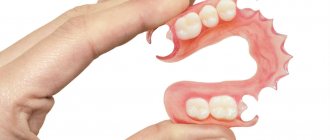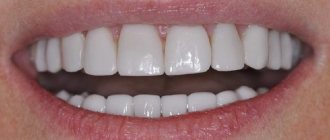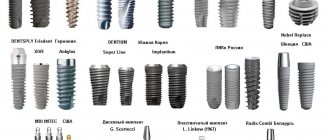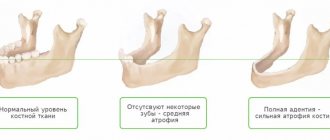In what cases is it necessary to install a filling?
The installation of restorative material is carried out not only in the treatment of carious lesions. The procedure is also performed when:
- presence of chips and cracks;
- elimination of consequences after mechanical damage;
- intense loss of hard tissues, leading to almost complete wear of the upper part of the teeth (for example, due to involuntary grinding of the jaws).
It is worth noting that any dental clinic performs filling only in cases where the destruction of the coronal part is insignificant. If the surface of the tooth is damaged by more than a third, it is replaced with an artificial substitute - a prosthesis.
The use of modern materials helps restore the beauty of the smile and chewing function, and also prevents further destruction of the mineralized coating.
Is a refilling necessary if nothing bothers me?
Many patients are surprised when a dentist recommends replacing an old filling with a new one, because they have no pain or other unpleasant symptoms. However, replacement is carried out not only in cases of severe inflammation, but also for preventive purposes, as well as to improve the aesthetics of the dentition.
Like any other material, the filling mass is subject to gradual wear, deformation, and destruction. Hygienic care, oral microorganisms, saliva pH, mechanical, chemical and temperature effects of food over time provoke the appearance of microscopic cracks in the filling. The resulting pores serve as a breeding ground for microbes and the development of dental diseases.
Good to know! After teeth whitening (especially when whitening by 8-15 shades), you will also need to start replacing old fillings, because they look darker than the new smile.
What types of fillings are there?
Depending on the period of use, temporary and permanent fillings are distinguished. The first ones are placed during treatment. For example, they cover a tooth for a while in order to understand whether the nerve is affected by caries or not. A temporary filling is also used to secure medications placed in a diseased tooth, or to secure arsenic after depulpation. After two weeks, temporary materials are replaced with permanent ones. The latter can last for years.
In modern dentistry, the following types of fillings are distinguished:
- Cement fillings are a budget option. They are difficult to grind, look unnatural and can cause destruction of the teeth they interact with.
- Metal (almagamic). They are made from an alloy of silver and copper, are characterized by increased strength, but also stand out against the background of the rest of the jaw. Often, fillings of this type are installed on teeth located further than the incisors.
- Composite fillings. They have a paste-like consistency and are applied in layers, so working with them does not cause much difficulty. Special ultraviolet light is used to fix composite materials. The variety of the palette allows you to choose a shade that will not differ from the native enamel, which is why composites are widely used for the restoration of anterior teeth.
- Ceramic fillings. In appearance and composition, they are as close as possible to the natural coating of teeth. Their production takes some time, so the fixation of the material is carried out in several stages. Ceramics are resistant to temperature changes. Its main advantage is also aesthetics.
How to extend the service life of filling material
How often the filling will have to be changed depends on how correctly it is used. To extend the life of the material, just listen to the following tips:
- don’t skimp on material: very cheap means it won’t last long,
- avoid increased stress on the filling: do not open bottles, avoid excessively hard foods,
- avoid sudden changes in temperature in the oral cavity: do not take too hot or cold food,
- select oral hygiene items and products in accordance with the characteristics of the teeth.
In addition, even in the absence of complaints, you need to regularly visit the dentist for timely detection of pathologies and defects. It is better to spend a few minutes grinding than to have to refill it after some time. Preventative visits will save time and money, and will also keep your nerves and teeth in perfect order.
What types of fillings are better?
Many dentists recommend installing fillings made of light-curing composite. They are characterized by increased strength and durability, and look natural. Composite fillings are suitable for filling cavities in distant teeth and restoring carious cavities, as well as for treating erosions of hard tissues. Their service life is 5 years.
Glass ionomer cement, which is a hybrid of acrylic and silicate components, is also considered a good choice for filling. Glass ionomer combines well with natural coatings and other established types of fillings; it is suitable for treating destructive processes of the tooth, filling the anatomical space under the roots, and preparing the cavity for further orthopedic manipulations.
Light-curing composite fillings
The components of a light-curing filling react to the glow of a special lamp. The polymerization lamp emits blue light, affecting the components of the filling in a special way; the wavelength is 450 nm.
Advantages of light-curing composite fillings:
- High aesthetics
- Large color palette;
- High strength;
- Low shrinkage;
- Long service life;
- The technology allows the dentist to make a more accurate anatomical shape.
Disadvantages of light-cured composite fillings:
— Higher cost compared to other types of fillings.
In “Royal Smile” dentistry, high-quality materials and reliable specialized equipment are used for fillings. The procedure for installing a filling is carried out by experienced dentists without pain at low prices.
How is the filling installed?
The fixing of the restoration material always follows the same pattern:
- First, the doctor injects into the tissues located around the damaged area.
- When the medicine begins to act, the specialist cleans the cavity from the remains of dead tissue, darkened mineralized parts and dentin, and gives it the desired shape and depth.
- The doctor then examines the pulp. If the connective tissue is not damaged, the prepared area is treated with an antiseptic. If the pulp is in a state of inflammation, then the dentist removes it from the tooth cavity and then fills the canals.
- After the above manipulations, the cavity is dried. Then special antimicrobial and insulating gaskets are placed in it.
- At the final stage, filling is carried out. At the end of the operation, the installed material is ground for comfortable closure of the jaws and polished.
Therapy - prices for dental treatment
| NAME OF SERVICE | COST, RUB. |
| Application anesthesia | RUB 100.00 |
| Infiltration anesthesia | RUB 600.00 |
| Conduction anesthesia | RUB 600.00 |
| Rg | RUB 300.00 |
| Trephination of the tooth crown | RUB 300.00 |
| Applying an insulating pad | RUB 500.00 |
| Applying a therapeutic pad | RUB 300.00 |
| Light filling 1st surface | RUR 2,200.00 |
| Light seal 2nd surface | RUR 2,900.00 |
| Partial pinless tooth restoration with light-curing material | RUR 3,700.00 |
| Chemical filling 1st surface | RUB 1,500.00 |
| Chemical seal 2nd surface | RUR 2,200.00 |
| Partial pinless tooth restoration with chemically cured material | RUB 3,000.00 |
| Polishing the filling | RUB 100.00 |
| Polishing a filling placed in another clinic | RUB 500.00 |
| Restoration of a tooth stump for a crown using a chemically cured material | RUB 3,800.00 |
| Restoration of a tooth stump for a crown using light-curing material | RUR 4,800.00 |
| Using an anchor or parapulp pin | RUB 1,000.00 |
| Using fiberglass pin | RUB 1,500.00 |
| Veneer made of light material | RUR 5,000.00 |
| Splinting in the area of the 1st tooth | RUB 1,700.00 |
| Opening of the tooth cavity and medicinal treatment | RUB 500.00 |
| Mechanical and medicinal treatment of the 1st channel | RUB 1,000.00 |
| Repeated medical treatment of the 1st canal for complicated periodontitis | RUB 400.00 |
| Mechanical and medicinal treatment of the 1st difficult canal | RUB 1,700.00 |
| Application of arsenic paste | RUB 300.00 |
| Filling the 1st channel with paste | RUB 1,000.00 |
| Filling the 1st canal with gutta-percha | RUB 1,000.00 |
| Temporary filling of the 1st channel | RUB 500.00 |
| Removing a foreign body from the canal | RUB 2,000.00 |
| Unsealing, mechanical and medicinal treatment of the 1st channel | RUB 1,700.00 |
| Unsealing, mechanical and medicinal treatment of the 1st difficult canal | RUR 2,300.00 |
| Unsealing, mechanical and medicinal treatment of the temporarily sealed 1st channel | RUB 300.00 |
| Removing the anchor pin | 1000.00 rub. |
| Temporary filling | RUB 300.00 |
See the price list for all dental prices
If, when treating caries, the doctor made a mistake or carried out incorrect treatment of the pulp, then caries will definitely begin to grow and progress. This can lead to periodontitis, in which it is necessary to thoroughly and thoroughly clean and seal the dental canals. If this is not done, the infection will go deeper and periodontitis will transform into periostitis. Dentists call “periostitis” inflammation of the periosteum, or the so-called “flux”. If it is not treated in a timely manner, the inflammatory process will affect the entire body and the person may lose a tooth. To reduce the risk of medical errors during treatment and filling of dental canals, it is advisable to carry out such endodontic procedures under a microscope.
When fighting caries, great attention should be paid to preventive measures. This means that the patient must carry out high-quality oral hygiene procedures and undergo regular medical examinations.
It is necessary to destroy caries in the first stages of its manifestation. To do this, it is necessary to use differentiated diagnostic technology. Then the doctor will not have to use a drill. He can do just fine with minimally invasive treatments.
After teeth filling
In some cases, after applying a filling, the sensitivity of the sealed tooth to external factors may increase: it may “ache” unpleasantly with any temperature change or when air enters. This most often happens when using composite materials. If the tooth remains sensitive two weeks after treatment, you should immediately consult a doctor.
A common cause of pain that occurs immediately after the anesthetic wears off can also be an excessive filling height. In this case, it should be reduced by the dentist.
The application of a filling is always accompanied by final grinding, during which the edges may remain sharp. Due to the action of the injection, this is often not felt immediately. If you notice protruding edges after the anesthetic has worn off, you should contact a dental clinic as soon as possible and make an appointment to straighten the tooth surface.
Fillings made of chemically cured composite
They harden due to chemical reactions that occur during the interaction of the components of the filling. The filling contains an organic matrix and an inorganic filler. The paste and special catalysts are mixed before applying the paste and after a few minutes they harden into the desired shape. If necessary, the dentist polishes them, making them more comfortable and natural in shape for the patient. Complete curing occurs within a day. The composite material is durable and aesthetic, suitable for restoring anterior teeth.
Advantages of chemical composite fillings:
- Large color palette;
- High strength;
- Uniform curing regardless of filling size;
- Does not dissolve from saliva;
- Do not split or crack.
Disadvantages of chemical composite fillings:
- May shrink over time
Rules for caring for fillings
Despite the fact that many fillings can theoretically last for years, it is recommended to change the materials every 10-12 years. It is recommended to visit a doctor once every six months for hygiene measures. You should also make an appointment with a doctor if:
- short-term pain in the treated area;
- detection of cracks;
- presence of a chip in the filling material.
The dentist can easily replace a bad filling with a new one.
If there is a large amount of restoration material in the cavity, you can ask the specialist to prescribe a gel with a high fluoride content. Its regular application will help strengthen the hard surface and prevent caries from forming again. Filled teeth may also be coated with fluoride varnish during the examination.
At home, it is recommended to use mouth rinses. With their help, you can significantly reduce the number of microbes that cause caries.
Summarizing the above, I would like to note that filling is a serious procedure. To prevent dental treatment under anesthesia from ending with repeated fillings and a double waste of time and money, you should seek help only from reliable, experienced specialists.
When is a refilling required?
To determine when a filling needs to be replaced, you should contact your dentist. He will conduct a diagnosis, including x-rays, and, if necessary, carry out a replacement.
Indications for refilling are the following conditions:
- pain in a filled tooth,
- crown destruction,
- detection of caries under filling material,
- feeling of an unpleasant taste,
- decreased aesthetics of the restoration,
- expiration of the seal's service life.
The most common situations in which refilling is required are discussed below.
Changing Hue
Yellowness, darkening and other color changes in the filling (and enamel) most often indicate the presence of a destructive process in the tooth. If there is a reddish tint, it means that the previously installed material contains resorcinol - in this case, not only a refilling is required, but also additional cleaning of the canals, as well as an internal bleaching procedure.
On a note! If the darkening is located on the border between the filling mass and the tooth tissue, this indicates a violation of the tightness. If timely refilling is not carried out, microbes will penetrate into the resulting space and caries will develop.
Abrasion of the filling mass
Over time, the fillings wear out, which leads to disruption of the distribution of chewing load. As a result, the bite changes, the load on the temporomandibular joint increases, TMJ pathologies develop, and digestive problems arise.
Overhanging filling
If installed incorrectly, the filling material may “hang” over the adjacent tooth or gum. The accumulation of food particles and impaired contact between units of the dentition provoke an inflammatory process in soft tissues, the proliferation of microorganisms and the development of caries, and bleeding gums.
Subsidence of the filling mass
Shrinkage is typical for any materials used for filling. If it occurs along the axis of the tooth, a person’s bite may change, which will lead to problems with the TMJ and digestion. In addition, vertical subsidence provokes the appearance of cracks and even chips in the tooth, since, as the filling contracts, it “pulls” the hard tissues along with it. When subsidence occurs in the horizontal plane, the degree of contact between adjacent units changes, food debris gets stuck in the interdental spaces, the formation of caries and gum inflammation are observed.
Flat filling surface
If, when filling, the dentist did not pay due attention to the chewing surface, but made it flat, disruption of the chewing process will gradually lead to the development of problems with the gastrointestinal tract. Normally, there are cusps and fissures on it, which ensures full contact with the opposite teeth of the other jaw.
Roughness has appeared
The rough surface of the filling indicates the presence of pores and microscopic cracks in it. This means that microbes have already penetrated into it. Often, when the filling material is removed in such cases, caries is revealed underneath it.
Expired service life
Even if the filling was installed more than 10-15 years ago and still holds, it does not mean that it is fulfilling its function. In the vast majority of cases, when refilling such “rarities”, an extensive carious process is determined.
Unaesthetic appearance
Refilling may be required if the previously installed filling stands out in shade from the background of the remaining teeth. Most often, the situation occurs after the whitening procedure. Over the period of operation, old compounds have absorbed various coloring substances, so to restore the aesthetic appearance (especially of the front units), they need to be replaced.
How long can you walk with a temporary filling?
A temporary filling can last for different periods of time, since everything depends on its composition, as well as on the specific disease:
- destruction of the nerve - up to 10 days with gentle means;
- treatment of periodontitis, elimination of inflammation - from 1 to 3 weeks, the time is calculated depending on the complexity and degree of the disease;
- Dentin augmentation or cyst treatment can take up to 3-6 months.
From this it can be seen that the filling is installed both for one day and for 6 months, so there is no single period - this issue is resolved individually. The filling still cannot last longer than six months, so you should plan your time in such a way as to be able to make it to the dentist’s visit - do not plan any long trips during the treatment period.
It is very important to have your teeth treated by a trusted specialist who can make an accurate diagnosis. Contact our clinic - we use the most modern instruments and filling compositions, and focus on the sterility and hygiene of the equipment. The doctor will check your teeth and, if necessary, place a temporary filling so that the treatment proceeds correctly and step by step.
Teeth brushing, additional items and hygiene products
Naturally, your teeth need to be brushed thoroughly. And teeth with fillings need to be cleaned even more thoroughly. There are several rules for this:
- The duration of brushing your teeth should be 2-3 minutes. Not less. You don’t need more either, you can damage your tooth enamel.
- Brush your teeth with sweeping movements from the gums to the chewing surface. Clean each surface of the teeth in turn, for example, first the outer ones, then the inner ones, then the chewing ones.
- Use dental floss. This is a special thread that you can clean between teeth that are difficult to reach with a brush.
- Buy an irrigator - this device for cleaning teeth with a jet of water under pressure ideally removes plaque. In combination with proper brushing of teeth, the irrigator gives an amazing effect, eliminating problems with teeth and gums for a long time.
- Don't get carried away with whitening pastes. They always contain an abrasive substance that will scratch the surface of the fillings. These scratches will gradually fill with food pigments and the original shine will disappear.
- Use mouth rinses after brushing your teeth; they keep your mouth fresh longer and have a beneficial effect on your teeth and gums.
- Avoid rough foods; the filling is made of a composite - in other words - plastic and can easily crack or even break off with part of the tooth. Let me remind you that we are talking about rough food - crackers, chocolate-covered roasted nuts or nuts with shells.
How does the replacement take place?
Many patients are worried: is it painful to change a filling? The procedure is performed under local anesthesia and is therefore absolutely painless.
In general terms, re-sealing occurs as follows:
- anesthesia is administered
- the desired tooth is isolated from the oral cavity with a rubber dam: so that moisture and microorganisms do not enter the treated cavity,
- old filling material and tissues affected by caries (if any) are removed
- the cavity is treated with a special etching solution and dried,
- an insulating or medicinal pad is applied,
- a new filling is applied.
Restoration takes place with mandatory consideration of the anatomical features of the chewing surface.




